YAMAHA TZR50 2010 Workshop Manual
Manufacturer: YAMAHA, Model Year: 2010, Model line: TZR50, Model: YAMAHA TZR50 2010Pages: 88, PDF Size: 1.83 MB
Page 51 of 88
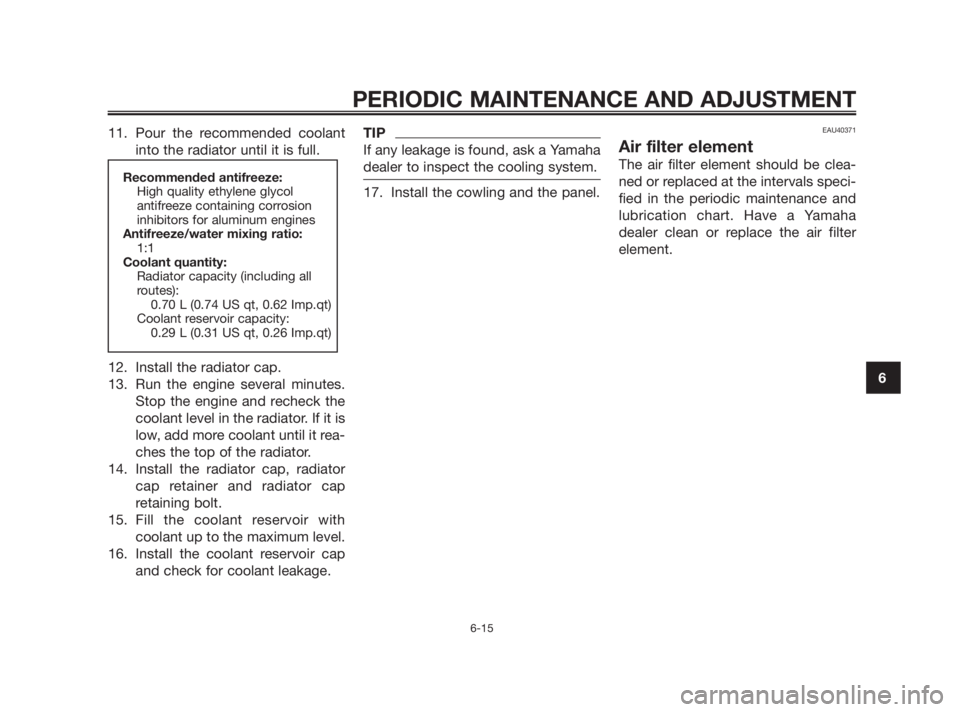
11. Pour the recommended coolant
into the radiator until it is full.
12. Install the radiator cap.
13. Run the engine several minutes.
Stop the engine and recheck the
coolant level in the radiator. If it is
low, add more coolant until it rea-
ches the top of the radiator.
14. Install the radiator cap, radiator
cap retainer and radiator cap
retaining bolt.
15. Fill the coolant reservoir with
coolant up to the maximum level.
16. Install the coolant reservoir cap
and check for coolant leakage.TIP
If any leakage is found, ask a Yamaha
dealer to inspect the cooling system.
17. Install the cowling and the panel.
EAU40371
Air filter element
The air filter element should be clea-
ned or replaced at the intervals speci-
fied in the periodic maintenance and
lubrication chart. Have a Yamaha
dealer clean or replace the air filter
element.Recommended antifreeze:
High quality ethylene glycol
antifreeze containing corrosion
inhibitors for aluminum engines
Antifreeze/water mixing ratio:
1:1
Coolant quantity:
Radiator capacity (including all
routes):
0.70 L (0.74 US qt, 0.62 Imp.qt)
Coolant reservoir capacity:
0.29 L (0.31 US qt, 0.26 Imp.qt)
PERIODIC MAINTENANCE AND ADJUSTMENT
6-15
6
5WX-F8199-E3 7/11/08 16:51 Página 51
Page 52 of 88
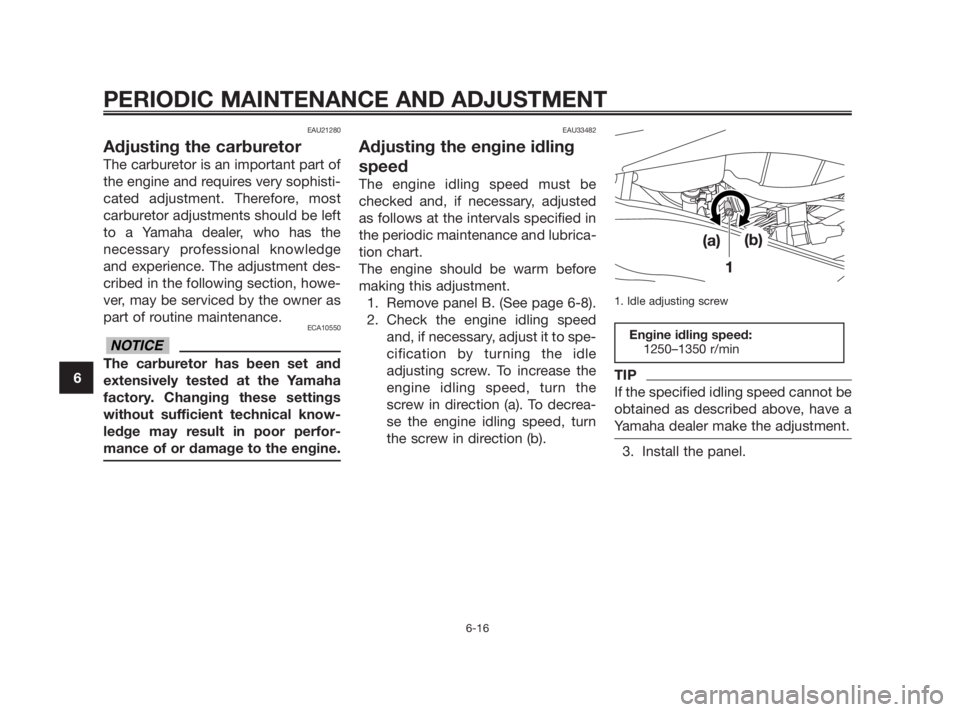
EAU21280
Adjusting the carburetor
The carburetor is an important part of
the engine and requires very sophisti-
cated adjustment. Therefore, most
carburetor adjustments should be left
to a Yamaha dealer, who has the
necessary professional knowledge
and experience. The adjustment des-
cribed in the following section, howe-
ver, may be serviced by the owner as
part of routine maintenance.
ECA10550
The carburetor has been set and
extensively tested at the Yamaha
factory. Changing these settings
without sufficient technical know-
ledge may result in poor perfor-
mance of or damage to the engine.
EAU33482
Adjusting the engine idling
speed
The engine idling speed must be
checked and, if necessary, adjusted
as follows at the intervals specified in
the periodic maintenance and lubrica-
tion chart.
The engine should be warm before
making this adjustment.
1. Remove panel B. (See page 6-8).
2. Check the engine idling speed
and, if necessary, adjust it to spe-
cification by turning the idle
adjusting screw. To increase the
engine idling speed, turn the
screw in direction (a). To decrea-
se the engine idling speed, turn
the screw in direction (b).
1. Idle adjusting screw
TIP
If the specified idling speed cannot be
obtained as described above, have a
Yamaha dealer make the adjustment.
3. Install the panel.
Engine idling speed:
1250–1350 r/minNOTICE
PERIODIC MAINTENANCE AND ADJUSTMENT
6-16
6
5WX-F8199-E3 7/11/08 16:51 Página 52
Page 53 of 88
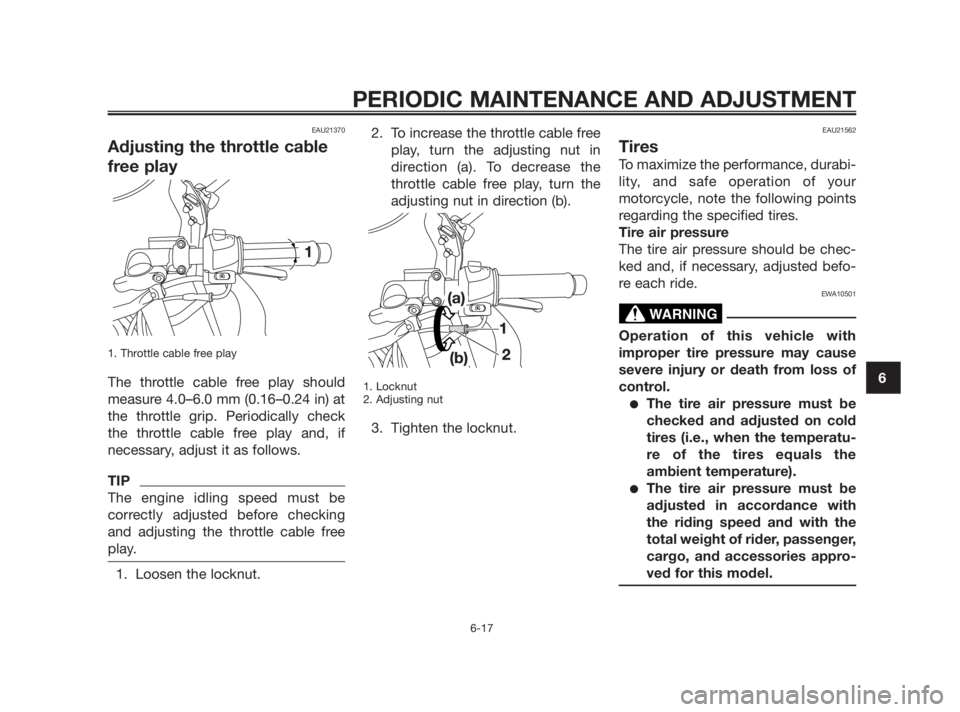
EAU21370
Adjusting the throttle cable
free play
1. Throttle cable free play
The throttle cable free play should
measure 4.0–6.0 mm (0.16–0.24 in) at
the throttle grip. Periodically check
the throttle cable free play and, if
necessary, adjust it as follows.
TIP
The engine idling speed must be
correctly adjusted before checking
and adjusting the throttle cable free
play.
1. Loosen the locknut.2. To increase the throttle cable free
play, turn the adjusting nut in
direction (a). To decrease the
throttle cable free play, turn the
adjusting nut in direction (b).
1. Locknut
2. Adjusting nut
3. Tighten the locknut.
EAU21562
Tires
To maximize the performance, durabi-
lity, and safe operation of your
motorcycle, note the following points
regarding the specified tires.
Tire air pressure
The tire air pressure should be chec-
ked and, if necessary, adjusted befo-
re each ride.
EWA10501
Operation of this vehicle with
improper tire pressure may cause
severe injury or death from loss of
control.
●The tire air pressure must be
checked and adjusted on cold
tires (i.e., when the temperatu-
re of the tires equals the
ambient temperature).
●The tire air pressure must be
adjusted in accordance with
the riding speed and with the
total weight of rider, passenger,
cargo, and accessories appro-
ved for this model.
WARNING
PERIODIC MAINTENANCE AND ADJUSTMENT
6-17
6
5WX-F8199-E3 7/11/08 16:51 Página 53
Page 54 of 88
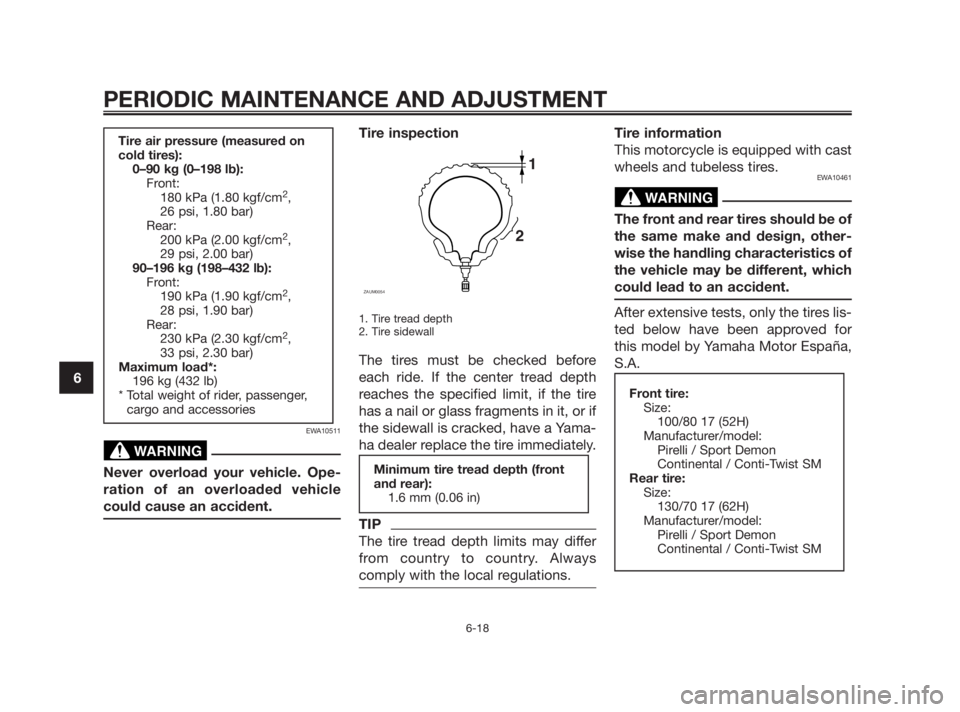
EWA10511
Never overload your vehicle. Ope-
ration of an overloaded vehicle
could cause an accident.
Tire inspection
1. Tire tread depth
2. Tire sidewall
The tires must be checked before
each ride. If the center tread depth
reaches the specified limit, if the tire
has a nail or glass fragments in it, or if
the sidewall is cracked, have a Yama-
ha dealer replace the tire immediately.
TIP
The tire tread depth limits may differ
from country to country. Always
comply with the local regulations.
Tire information
This motorcycle is equipped with cast
wheels and tubeless tires.
EWA10461
The front and rear tires should be of
the same make and design, other-
wise the handling characteristics of
the vehicle may be different, which
could lead to an accident.
After extensive tests, only the tires lis-
ted below have been approved for
this model by Yamaha Motor España,
S.A.
Front tire:
Size:
100/80 17 (52H)
Manufacturer/model:
Pirelli / Sport Demon
Continental / Conti-Twist SM
Rear tire:
Size:
130/70 17 (62H)
Manufacturer/model:
Pirelli / Sport Demon
Continental / Conti-Twist SM
WARNING
Minimum tire tread depth (front
and rear):
1.6 mm (0.06 in)
1
2
ZAUM0054
WARNING
Tire air pressure (measured on
cold tires):
0–90 kg (0–198 lb):
Front:
180 kPa (1.80 kgf/cm
2,
26 psi, 1.80 bar)
Rear:
200 kPa (2.00 kgf/cm
2,
29 psi, 2.00 bar)
90–196 kg (198–432 lb):
Front:
190 kPa (1.90 kgf/cm
2,
28 psi, 1.90 bar)
Rear:
230 kPa (2.30 kgf/cm
2,
33 psi, 2.30 bar)
Maximum load*:
196 kg (432 lb)
* Total weight of rider, passenger,
cargo and accessories
PERIODIC MAINTENANCE AND ADJUSTMENT
6-18
6
5WX-F8199-E3 7/11/08 16:51 Página 54
Page 55 of 88
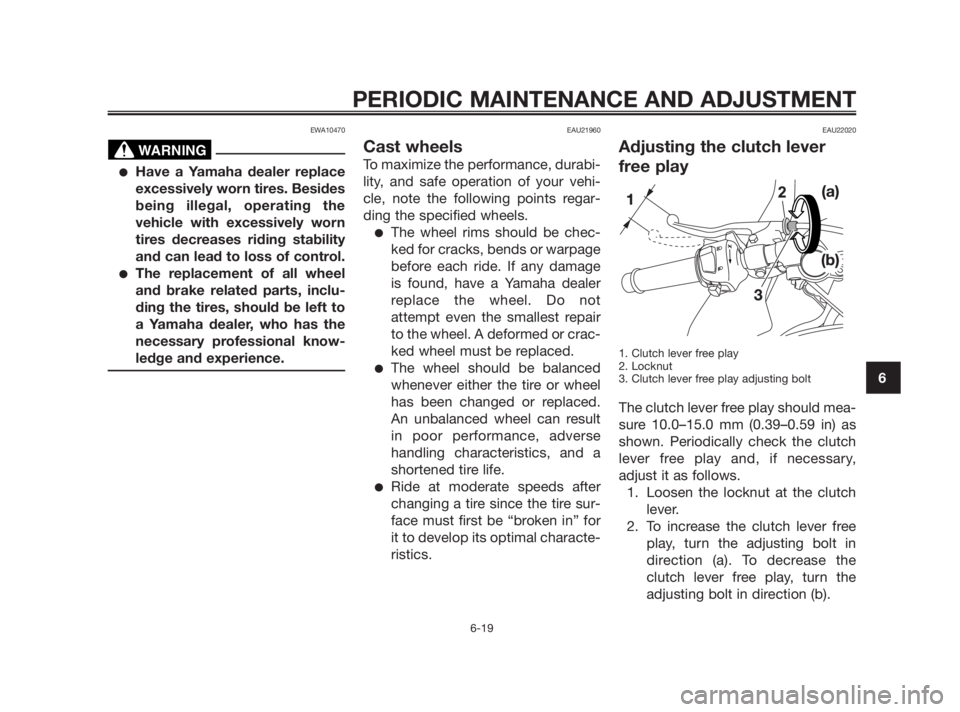
EWA10470
●Have a Yamaha dealer replace
excessively worn tires. Besides
being illegal, operating the
vehicle with excessively worn
tires decreases riding stability
and can lead to loss of control.
●The replacement of all wheel
and brake related parts, inclu-
ding the tires, should be left to
a Yamaha dealer, who has the
necessary professional know-
ledge and experience.
EAU21960
Cast wheels
To maximize the performance, durabi-
lity, and safe operation of your vehi-
cle, note the following points regar-
ding the specified wheels.
●The wheel rims should be chec-
ked for cracks, bends or warpage
before each ride. If any damage
is found, have a Yamaha dealer
replace the wheel. Do not
attempt even the smallest repair
to the wheel. A deformed or crac-
ked wheel must be replaced.
●The wheel should be balanced
whenever either the tire or wheel
has been changed or replaced.
An unbalanced wheel can result
in poor performance, adverse
handling characteristics, and a
shortened tire life.
●Ride at moderate speeds after
changing a tire since the tire sur-
face must first be “broken in” for
it to develop its optimal characte-
ristics.
EAU22020
Adjusting the clutch lever
free play
1. Clutch lever free play
2. Locknut
3. Clutch lever free play adjusting bolt
The clutch lever free play should mea-
sure 10.0–15.0 mm (0.39–0.59 in) as
shown. Periodically check the clutch
lever free play and, if necessary,
adjust it as follows.
1. Loosen the locknut at the clutch
lever.
2. To increase the clutch lever free
play, turn the adjusting bolt in
direction (a). To decrease the
clutch lever free play, turn the
adjusting bolt in direction (b).
WARNING
PERIODIC MAINTENANCE AND ADJUSTMENT
6-19
6
5WX-F8199-E3 7/11/08 16:51 Página 55
Page 56 of 88
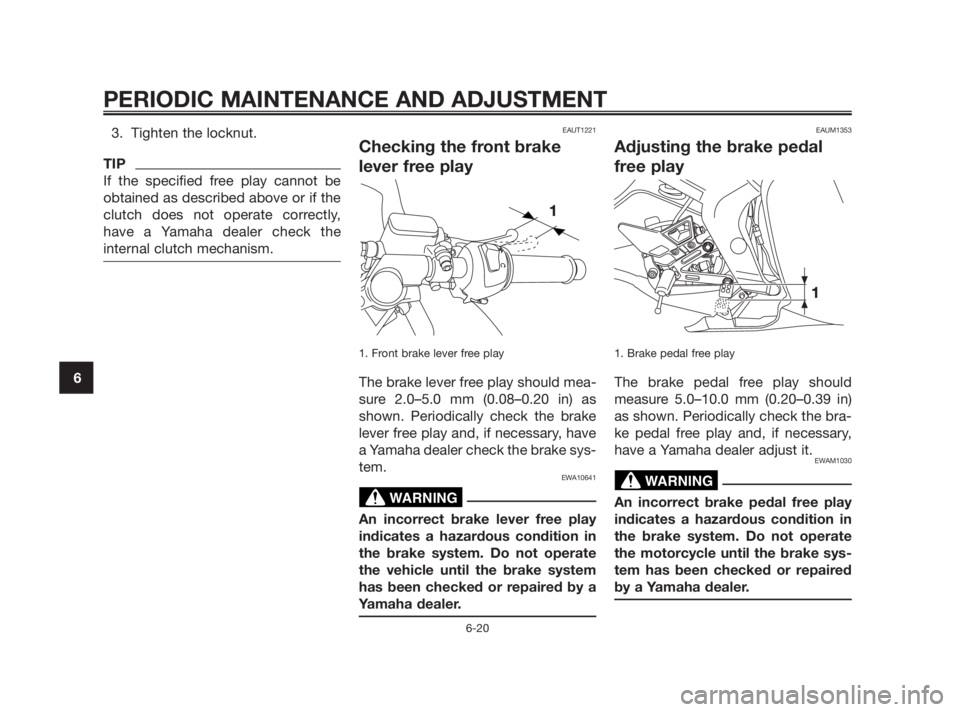
3. Tighten the locknut.
TIP
If the specified free play cannot be
obtained as described above or if the
clutch does not operate correctly,
have a Yamaha dealer check the
internal clutch mechanism.
EAUT1221
Checking the front brake
lever free play
1. Front brake lever free play
The brake lever free play should mea-
sure 2.0–5.0 mm (0.08–0.20 in) as
shown. Periodically check the brake
lever free play and, if necessary, have
a Yamaha dealer check the brake sys-
tem.
EWA10641
An incorrect brake lever free play
indicates a hazardous condition in
the brake system. Do not operate
the vehicle until the brake system
has been checked or repaired by a
Yamaha dealer.
EAUM1353
Adjusting the brake pedal
free play
1. Brake pedal free play
The brake pedal free play should
measure 5.0–10.0 mm (0.20–0.39 in)
as shown. Periodically check the bra-
ke pedal free play and, if necessary,
have a Yamaha dealer adjust it.
EWAM1030
An incorrect brake pedal free play
indicates a hazardous condition in
the brake system. Do not operate
the motorcycle until the brake sys-
tem has been checked or repaired
by a Yamaha dealer.
WARNING
WARNING
PERIODIC MAINTENANCE AND ADJUSTMENT
6-20
6
5WX-F8199-E3 7/11/08 16:51 Página 56
Page 57 of 88

EAUB1100
Adjusting the shift pedal
position
1. Distance between shift pedal and footrest
The top of the shift pedal should be
positioned approximately 65 mm
(2.56 in) below the top of the footrest
as shown. Periodically check the shift
pedal position and, if necessary, have
a Yamaha dealer adjust it.
EAU22272
Adjusting the rear brake light
switch
1. Rear brake light switch adjusting nut
2. Brake light switch
The rear brake light, which is activa-
ted by the brake pedal, should come
on just before braking takes effect. If
necessary, adjust the rear brake light
switch as follows.
Turn the rear brake light switch adjus-
ting nut while holding the rear brake
light switch in place. To make the bra-
ke light come on earlier, turn the
adjusting nut in direction (a). To make
the brake light come on later, turn the
adjusting nut in direction (b).
EAU22390
Checking the front and rear
brake pads
The front and rear brake pads must
be checked for wear at the intervals
specified in the periodic maintenance
and lubrication chart.
EAU22430
Front brake pads
1. Brake pad wear indicator groove
Each front brake pad is provided with
wear indicator grooves, which allow
you to check the brake pad wear wit-
hout having to disassemble the brake.
To check the brake pad wear, check
the wear indicator grooves. If a brake
pad has worn to the point that the
wear indicator grooves have almost
PERIODIC MAINTENANCE AND ADJUSTMENT
6-21
6
5WX-F8199-E3 7/11/08 16:51 Página 57
Page 58 of 88
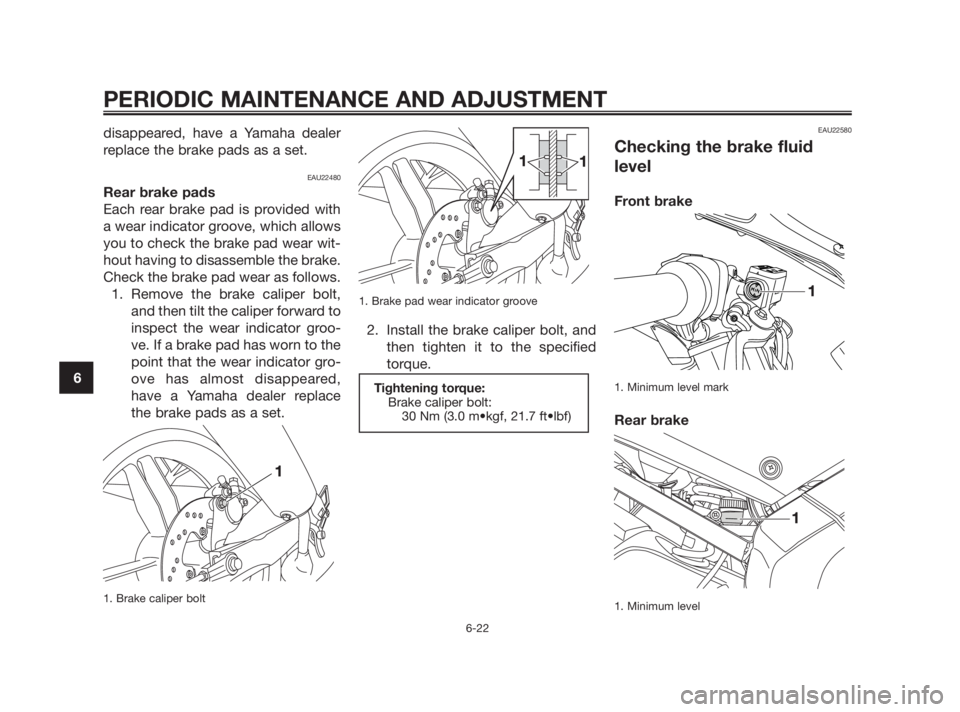
disappeared, have a Yamaha dealer
replace the brake pads as a set.
EAU22480
Rear brake pads
Each rear brake pad is provided with
a wear indicator groove, which allows
you to check the brake pad wear wit-
hout having to disassemble the brake.
Check the brake pad wear as follows.
1. Remove the brake caliper bolt,
and then tilt the caliper forward to
inspect the wear indicator groo-
ve. If a brake pad has worn to the
point that the wear indicator gro-
ove has almost disappeared,
have a Yamaha dealer replace
the brake pads as a set.
1. Brake caliper bolt1. Brake pad wear indicator groove
2. Install the brake caliper bolt, and
then tighten it to the specified
torque.
EAU22580
Checking the brake fluid
level
Front brake
1. Minimum level mark
Rear brake
1. Minimum level
Tightening torque:
Brake caliper bolt:
30 Nm (3.0 m•kgf, 21.7 ft•lbf)
PERIODIC MAINTENANCE AND ADJUSTMENT
6-22
6
5WX-F8199-E3 7/11/08 16:51 Página 58
Page 59 of 88
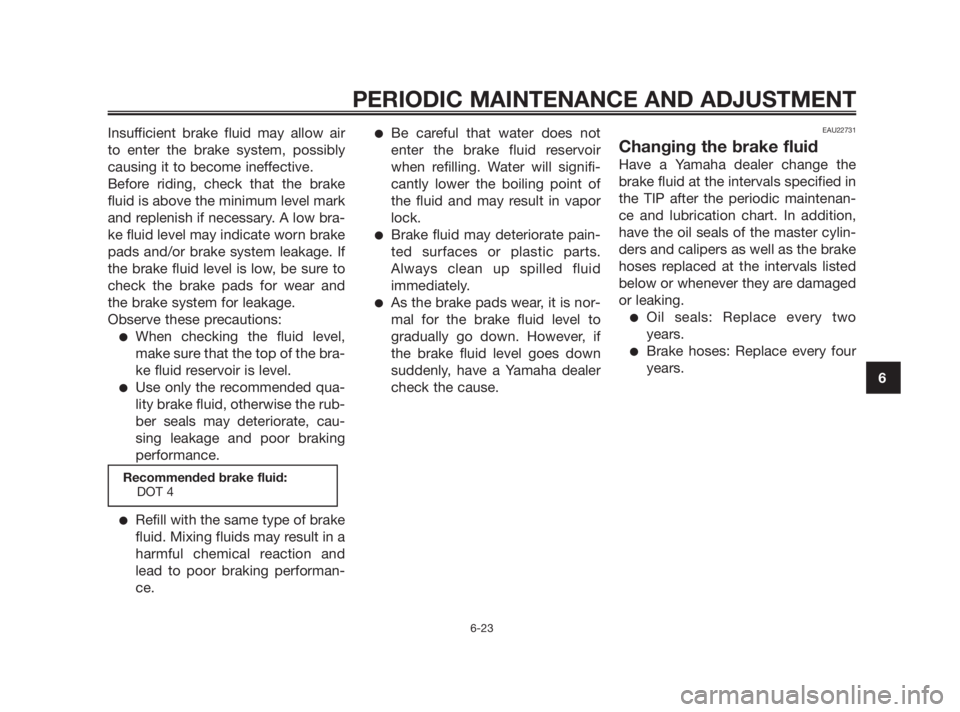
Insufficient brake fluid may allow air
to enter the brake system, possibly
causing it to become ineffective.
Before riding, check that the brake
fluid is above the minimum level mark
and replenish if necessary. A low bra-
ke fluid level may indicate worn brake
pads and/or brake system leakage. If
the brake fluid level is low, be sure to
check the brake pads for wear and
the brake system for leakage.
Observe these precautions:
●When checking the fluid level,
make sure that the top of the bra-
ke fluid reservoir is level.
●Use only the recommended qua-
lity brake fluid, otherwise the rub-
ber seals may deteriorate, cau-
sing leakage and poor braking
performance.
●Refill with the same type of brake
fluid. Mixing fluids may result in a
harmful chemical reaction and
lead to poor braking performan-
ce.
●Be careful that water does not
enter the brake fluid reservoir
when refilling. Water will signifi-
cantly lower the boiling point of
the fluid and may result in vapor
lock.
●Brake fluid may deteriorate pain-
ted surfaces or plastic parts.
Always clean up spilled fluid
immediately.
●As the brake pads wear, it is nor-
mal for the brake fluid level to
gradually go down. However, if
the brake fluid level goes down
suddenly, have a Yamaha dealer
check the cause.
EAU22731
Changing the brake fluid
Have a Yamaha dealer change the
brake fluid at the intervals specified in
the TIP after the periodic maintenan-
ce and lubrication chart. In addition,
have the oil seals of the master cylin-
ders and calipers as well as the brake
hoses replaced at the intervals listed
below or whenever they are damaged
or leaking.
●Oil seals: Replace every two
years.
●Brake hoses: Replace every four
years.
Recommended brake fluid:
DOT 4
PERIODIC MAINTENANCE AND ADJUSTMENT
6-23
6
5WX-F8199-E3 7/11/08 16:51 Página 59
Page 60 of 88
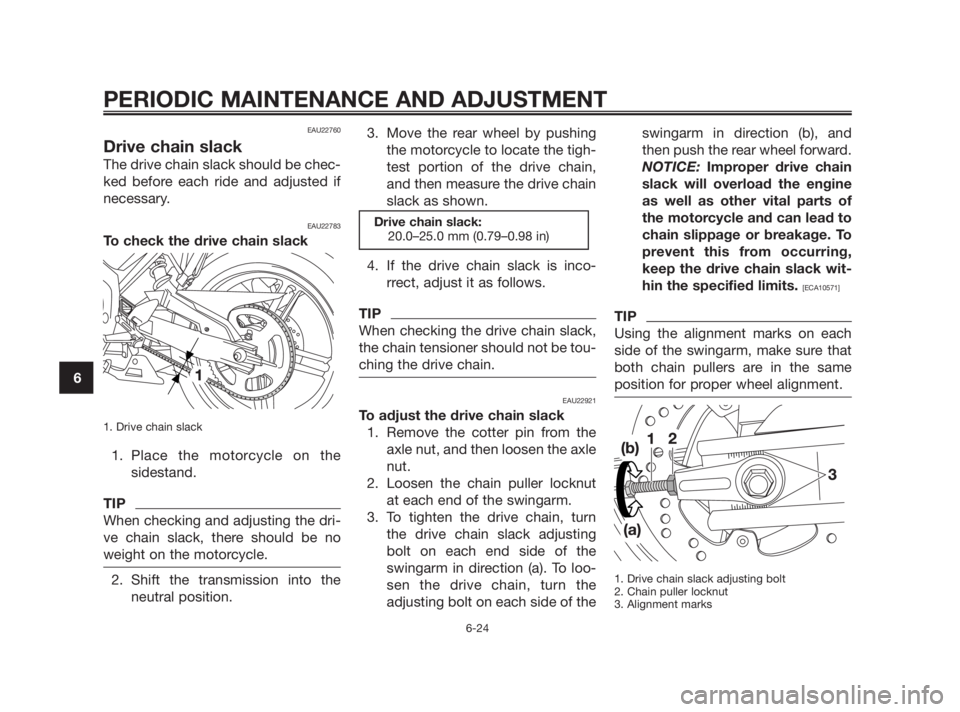
EAU22760
Drive chain slack
The drive chain slack should be chec-
ked before each ride and adjusted if
necessary.
EAU22783
To check the drive chain slack
1. Drive chain slack
1. Place the motorcycle on the
sidestand.
TIP
When checking and adjusting the dri-
ve chain slack, there should be no
weight on the motorcycle.
2. Shift the transmission into the
neutral position.3. Move the rear wheel by pushing
the motorcycle to locate the tigh-
test portion of the drive chain,
and then measure the drive chain
slack as shown.
4. If the drive chain slack is inco-
rrect, adjust it as follows.
TIP
When checking the drive chain slack,
the chain tensioner should not be tou-
ching the drive chain.
EAU22921
To adjust the drive chain slack
1. Remove the cotter pin from the
axle nut, and then loosen the axle
nut.
2. Loosen the chain puller locknut
at each end of the swingarm.
3. To tighten the drive chain, turn
the drive chain slack adjusting
bolt on each end side of the
swingarm in direction (a). To loo-
sen the drive chain, turn the
adjusting bolt on each side of theswingarm in direction (b), and
then push the rear wheel forward.
NOTICE: Improper drive chain
slack will overload the engine
as well as other vital parts of
the motorcycle and can lead to
chain slippage or breakage. To
prevent this from occurring,
keep the drive chain slack wit-
hin the specified limits.
[ECA10571]
TIP
Using the alignment marks on each
side of the swingarm, make sure that
both chain pullers are in the same
position for proper wheel alignment.
1. Drive chain slack adjusting bolt
2. Chain puller locknut
3. Alignment marks
Drive chain slack:
20.0–25.0 mm (0.79–0.98 in)
PERIODIC MAINTENANCE AND ADJUSTMENT
6-24
6
5WX-F8199-E3 7/11/08 16:51 Página 60